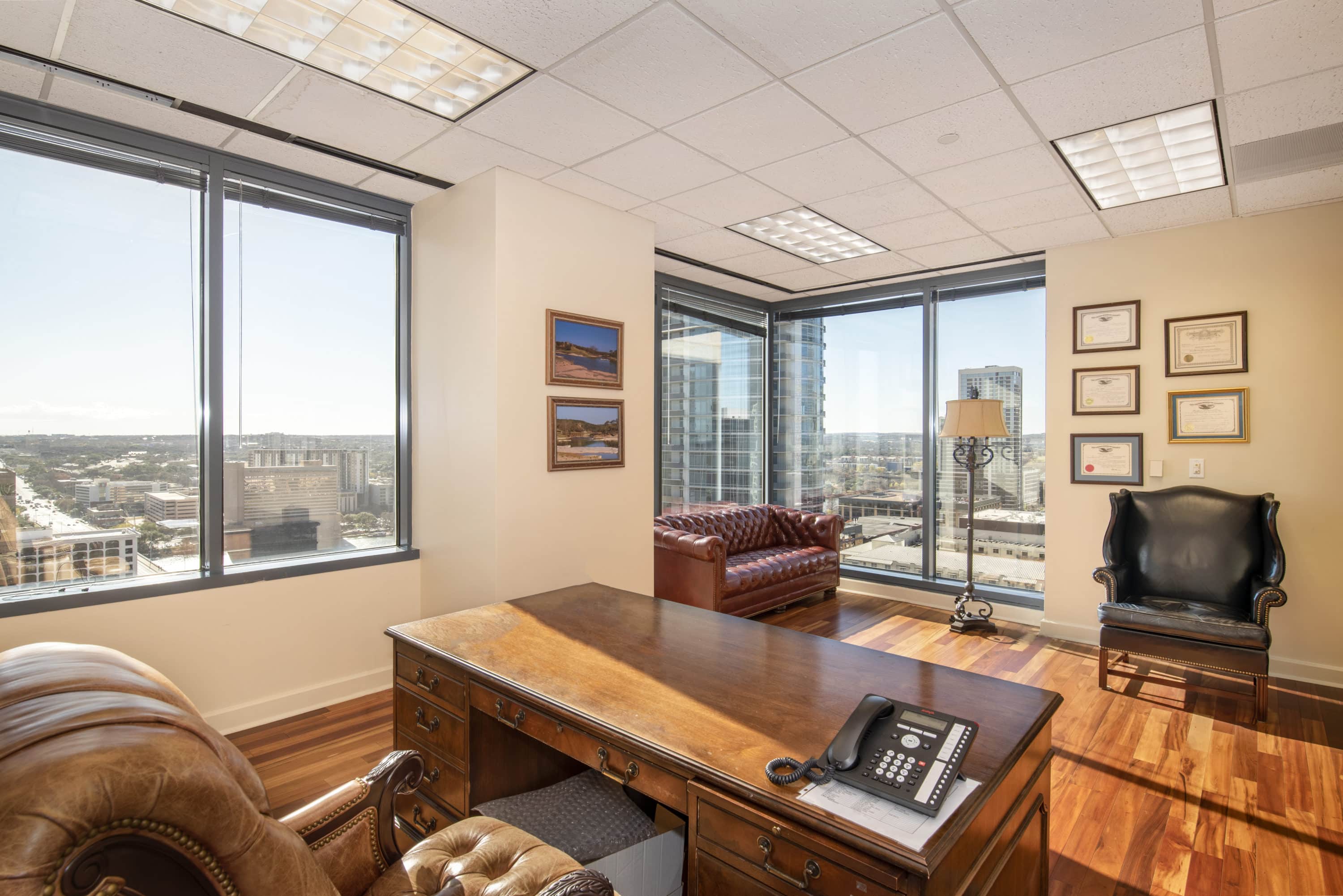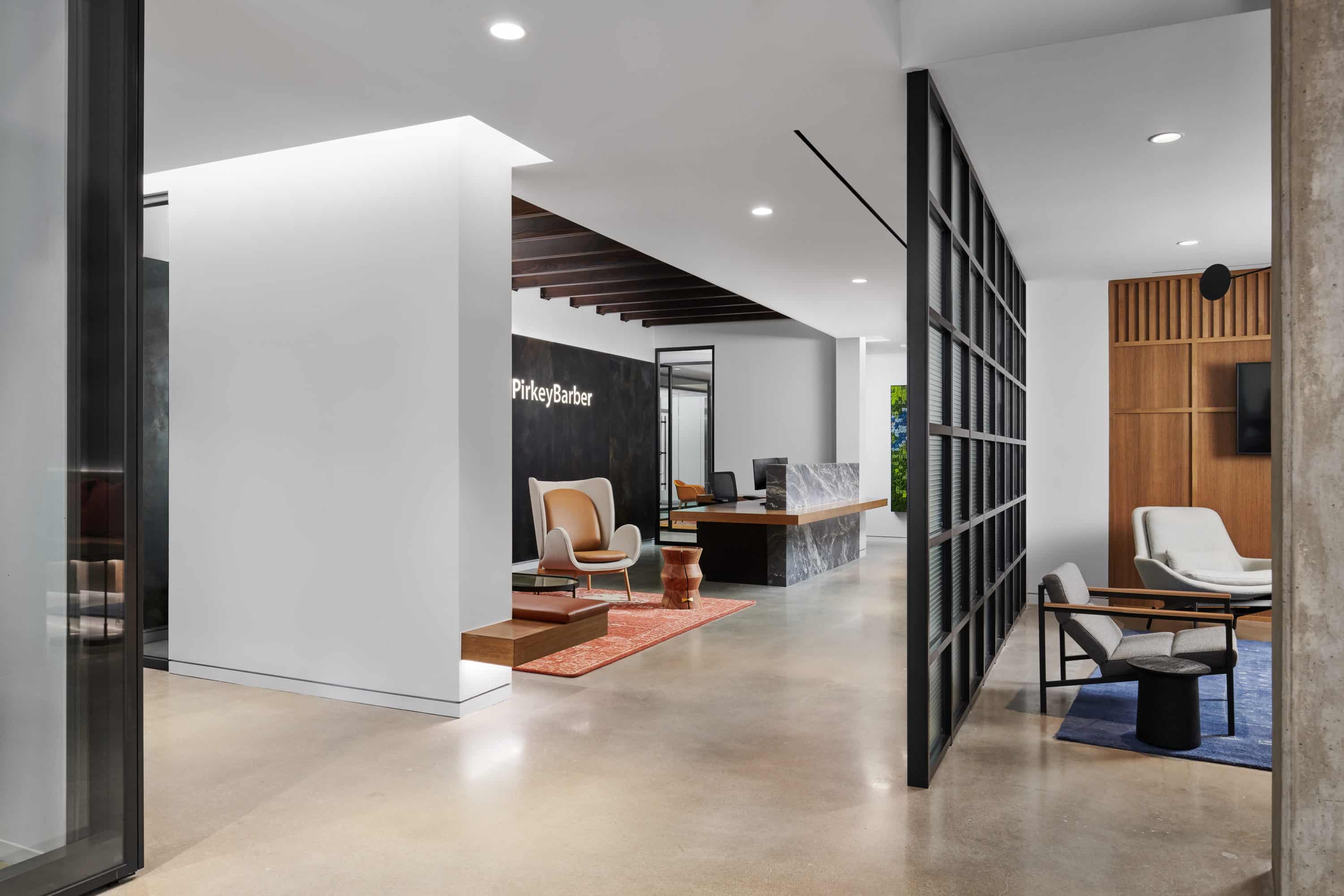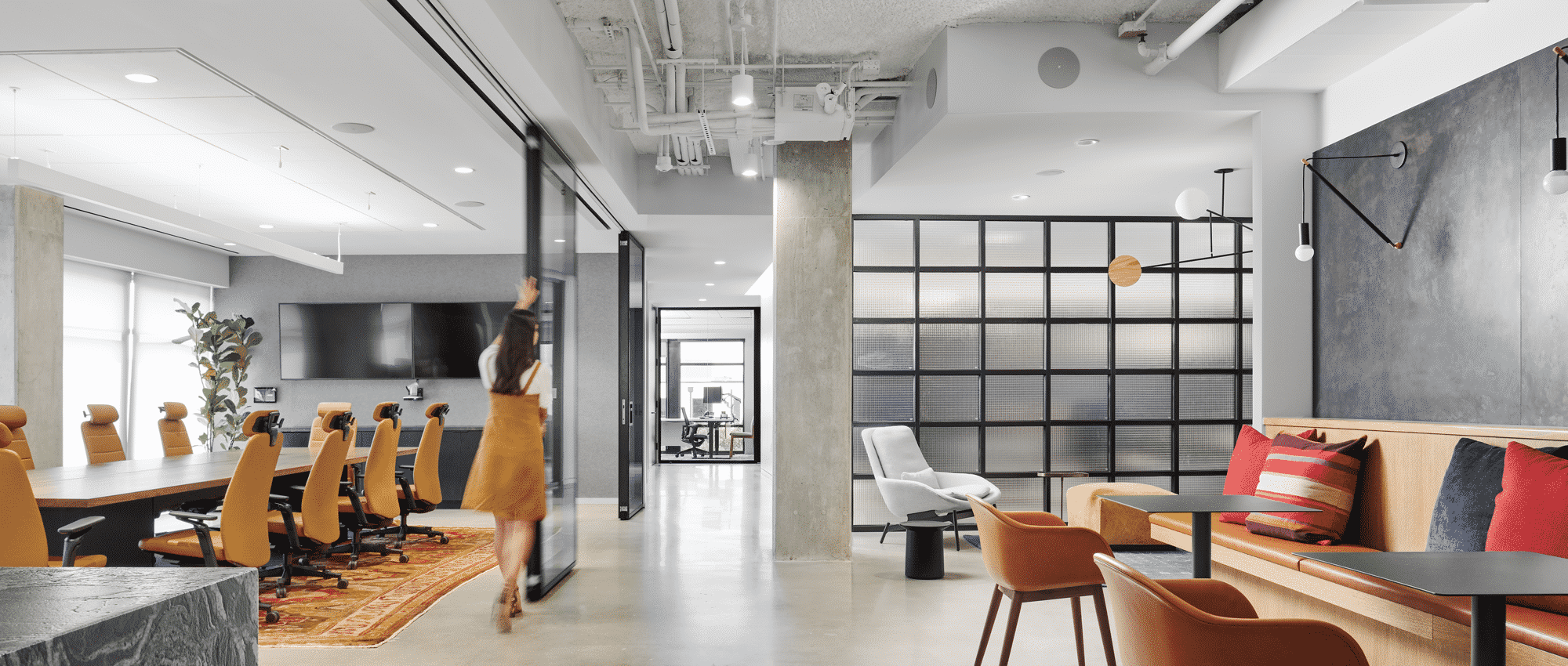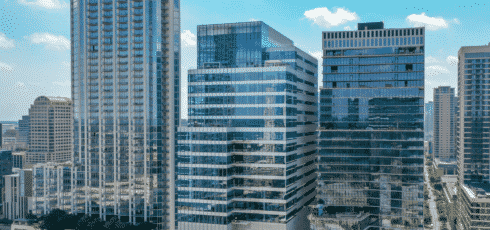This article was originally published in AQUILA’s 4Q 2019 Austin Office Market Report. This article will not be updated, but please contact us if you have specific questions regarding the information in this article.
In the realm of commercial real estate brokerage, law firms are frequently seen as the creme de la creme of tenants; they are often experts at navigating the complexities of negotiations, are known for signing long-term, large leases, and often occupy space in the highest quality buildings a city has to offer. Entire brokerage careers have been built on helping law firms find office space, so it’s no wonder they are such sought-after clients.
But what if the traditionally assumed requirements for law firm tenants are no longer accurate? Specifically, what if the needs of law firm tenants in Austin are changing?
In this special report, we will answer these questions as it relates to:
- What does a traditional law firm look like in Austin?
- How have space needs changed for law firms?
- Is a downtown address still a necessity?
What Does a Traditional Law Firm Look Like in Austin?
Before we dive into how law firms are changing, let’s begin by defining the law firm landscape in Austin today.
Although Austin may not have the same volume of law firms as Dallas or New York, they still comprise roughly 5% of the total existing Class A office space citywide and 12% of the existing Class A office space in the CBD according to CoStar. Below you can see where the majority of these firms are located, as well as some of the largest law firms in Austin.
AUSTIN LAW FIRMS BY SUBMARKET

LARGE LAW OFFICES IN AUSTIN
| Tenant | Property Name | Submarket | Size | Lease Term |
| Vinson & Elkins LLP | The Terrace 7 | Southwest | 91,575 SF | 120 months |
| Baker Botts | San Jacinto Center | CBD | 62,000 SF | 182 months |
| McGinnis Lochridge | 600 Congress Ave. | CBD | 59,276 SF | 60 months |
| Winstead PC | Frost Bank Tower | CBD | 51,875 SF | 240 months |
| Graves, Dougherty, Hearon & Moody, P.C. | Frost Bank Tower | CBD | 50,438 SF | 180 months |
| Husch Blackwell | One Eleven | CBD | 45,823 SF | 120 months |
| DLA Piper | Frost Bank Tower | CBD | 40,000 SF | 144 months |
Historically, law offices like these have been known for high-end finishes, large private offices along the exterior windows, and seating for support staff within the interior of the space. For the firms that could afford to do so, these spaces were often located on the upper floors of downtown high-rises, generally as close to the courthouse and capitol as possible. Many firms also signed long-term leases and frequently renewed their lease rather than relocating. The look and feel of the office space is an important recruitment tool for both talent and clients, so even today special attention is paid to those factors. However, many law firms in Austin are opting to do so in a slightly different fashion.

Traditional law firm space available for sublease at 301 Congress.
How Are Space Needs Changing for Law Firms?
According to CBRE’s “A Shifting Landscape: 2019 North American Legal Sector Trends” study, 57.1% of law firm transactions in Austin between 3Q 2018 to 2Q 2019 were expansions and 17.3% were contractions. Of the law firms that contracted, the average decrease in space was 23%. In addition, an impressive 66.6% of all law firm transactions were relocations while 23.5% were renewals and 9.9% were new leases.
This made us wonder, if law firms in Austin are changing their spaces so drastically and overwhelmingly opting to relocate to different buildings, what is the cause?
To help us answer this question, we enlisted the help of Kendi Sparks and Raul Baeza at IA Interior Architects who have assisted numerous law firm clients navigate their space needs.
Q: Although some law firms are moving into bigger spaces, they are also allocating less space per employee. Are you hearing that increasing rental rates are their reason for doing so or are there other variables?
RAUL: It’s probably a combination. Technology companies are starting to take over the large swaths of real estate in the CBD, and that creates a need for law firms to look at other locations. I think the other factor is that firms are becoming more multigenerational. You’re seeing a shift from the Baby Boomers to Gen X and Millennials, which tend to have a different work styles. Whenever we are working with law firms, we work to understand these generational differences and have had a lot of success.
Density needs in the law firm sector are also changing. Whereas 10 years ago a law firm might have had one to two lawyers per legal assistant, today firms are transitioning to between three to five lawyers per assistant. Regardless of whether this is a cause or effect of downsizing, it undoubtedly provides for a smaller, more efficient use of space.
Q: Are you still seeing large private offices or have those completely gone away?
RAUL: Most law firms are still evaluating them. With one of our Southwest Austin clients, we did see that only two of the offices out of 45 were large attorney offices, but I think the conversation is still going on based on the client’s feedback.
KENDI: It’s also important to think about the future of the company and setting up those large offices to be convertible to meeting rooms when those existing leaders either retire or move on from the company in the future.

A large private office at 301 Congress.
Q: What would you say are the most important questions a law firm should be asking as it plans a new space? Are there any decisions that need to be made early on in the process?
RAUL: I think data adjacency is a big one when looking at test plans. For example, thinking about the proximity of legal assistants to private offices, printers, files, etc. That is a big conversation that we push to have near the beginning of the design process. I think firms tend to leave the seating arrangement towards the end of the test fit, but it does create a lot of work if that’s not established at the beginning.
KENDI: Also, making that decision on private offices versus workstations and open areas will have a trickle effect throughout the rest of the design, so answering those questions early on is key.
Q: In your experience, what are the most common amenities law firms want in their office suite today?
RAUL: We have started to see more of a need for lounge areas and creating more of a living room setting where people can go sit in an area that’s not an office or meeting room. And also there has been a shift in break room design for firms moving out of the CBD. Traditionally the windows were being allocated for private offices while break rooms were more centralized, but now the break rooms are being given more importance and being pushed against the perimeter glazing so that they have more natural light and will be used more frequently.
KENDI: There’s a need for convertible space because, with today’s real estate costs, you don’t want to have a big open area for everyone to meet that only gets used once a quarter or once a year. Having the ability to incorporate mobility in the partitions of those larger rooms allows the firm to adjust depending on the momentary need. Some of the law firms we have worked with who have implemented this feature have said that their clients are even asking to host events in their space. Creating a space and atmosphere for this is not only great for internal use but for marketing purposes as well.
Q: There’s a common perception in the real estate market of what a traditional law firm space and a creative tech suite look like. When thinking about new build-outs, are those spaces really that different or have they started to move towards the same trends?
KENDI: Whether it’s a tech company or a law firm there are different levels of privacy needs depending on the company. In tech firms, trends over the past decade reflected dense open office areas with low panels. Now we are seeing that pendulum swing back in the opposite direction to provide more opportunities for increased privacy through larger workstations or higher panels. This is similar to the workstations that you might find in the open office portion of a law firm.
RAUL: Ergonomics* is another big one. Ergonomics have been such a big part of the conversation in the tech industry in recent years, and now we are seeing that come into law firms as well. With law firms, we do have to consider how to incorporate ergonomics without sacrificing the look of a nicer piece of furniture, but it’s definitely becoming more important and we are having those conversations.
*Ergonomics – Designing a workplace to increase productivity and decrease discomfort. In an office environment, this can include adjustable chairs, standing desks, encouraging proper posture, and opportunities to move around throughout the day.

Modern law firm space in East Austin designed by IA Interior Architects. Photography by Peter Molick.
Q: As law firms plan ahead for the future, what changes do you see happening 10 years down the road?
RAUL: Going paperless is starting to be considered depending on the type of law they practice. For one of our trademark law firm clients, we saw them go totally paperless, but I think for other types that still require the physical, legacy type information we will still have to plan for some storage. We don’t see large, high-density rooms for file storage as much, but we do now see storage incorporated throughout the office, for example adding storage underneath a cabinet or counter.
KENDI: And specifically for one of our law firm clients in Southwest Austin, a high-density file storage room would be costly both from a construction and real estate perspective, so they are having to consider either off-site storage or storage on the cloud.
Q: What is the best/most interesting example of a “modern” law office that you have worked on recently?
RAUL: The most progressive one that we have done was for a law firm on Austin’s Eastside. From a square footage standpoint, how they chose to allocate their space was something we hadn’t seen before. They opted to have an admin-to-attorney ratio of closer to 1:5 and had about 420 square feet per attorney whereas traditionally we see about 900 square feet.
KENDI: I was in New York recently with one of the thought leaders in the industry, and this project was definitely one of the most efficient and progressive law firm spaces they had seen. I think one of the challenges we face in Austin, is that many firms here are branches of larger firms and not the home office, so we have to get a little more creative with our budgets.
Is a Downtown Address Still Necessary?
Perhaps the most important question large law firms in Austin are asking themselves is whether it is still vital to locate in the CBD. Historically, law firms have located primarily in the CBD both by necessity (to be close to the courthouse and capitol) as well as for prestige (a Congress Avenue address looks good on a business card). However, as CBD rental rates continue to climb, is the CBD still worth it?
For many law firms, the answer is no.
Aside from the firms already located outside the CBD, several others have begun to make the move. Pirkey Barber, for instance, recently moved from its downtown office at 600 Congress to 1801 East 6th on Austin’s trendy Eastside, and Baker Botts opted to downsize and sign a pre-lease at RiverSouth rather than signing a renewal for its space at San Jacinto Center. For these law firms and others like them, the cost of officing downtown is starting to outweigh the benefits.

Pirkey Barber’s space on Austin’s trendy Eastside. Aside from the firms already located outside the CBD, several others have begun to make the move. Pirkey Barber recently moved its downtown office at 600 Congress to 1801 East 6th. Photography by Peter Molick.
According to the Austin Business Journal, traffic is another reason cited as why law firms are looking elsewhere for office space.1 It can be a hassle getting into and out of downtown during rush hour, and even once you arrive the limited parking options add another layer of inconvenience to an office visit. Parking costs in the CBD have also increased substantially, with buildings charging upwards of $300 per space per month.
From AQUILA’s work with downtown law firms, we also know that some firms have been searching elsewhere because of the increasing presence of tech companies in downtown high-rises, which often have a high density (resulting in crowded elevators, strained facilities, etc.) and don’t typically generate the same professional atmosphere that most law firms are looking for.
So, while locating in the CBD does come with its benefits, it’s important for law firms to also consider the drawbacks when making their real estate decisions.
Conclusion
Although law firms in Austin are not building massive campuses like some of their tech company counterparts, they do still make up an important subset of occupied office space, especially in the CBD. As these firms continue to evolve, both in what they look for in office space and how they do business, it will be interesting to see the type and location of space that will become the norm in the future.
1 Source: Austin Business Journal – Prices, traffic push some law firms out of downtown Austin









